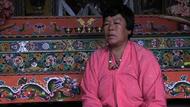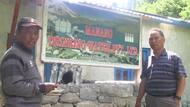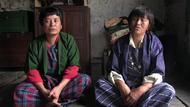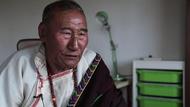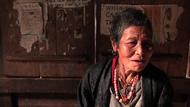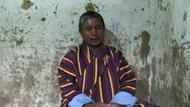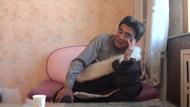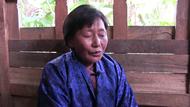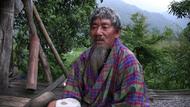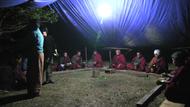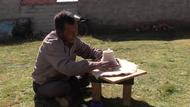Video Overview
༉ པདྨ་དགའ་ཚལ་རེས་སི་ནང་ལས་ དབང་འདུས་དེ་ སྐྱེས་ལོ་ ༡༥ སྦེ་སྡོད་པའི་སྐབས་ལས་ར་ ཁོ་ར་རྩེདམོ་རྩེ་བའི་ཞོར་ཁ་ལས་འབད་ ད་རེས་ནངས་པར་ ཞལ་འབགཔ་ཚུ་བཟོ་ནི་ལུ་ཉམས་མྱོང་ཅན་ཅིག་ཨིན་མས། རས་སི་ནང་གཡུས་ཚན་དེ་ ཧེ་མ་ཁོ་ར་དྲནམ་བཏགས་མ་བཏགསཔ་ཅིག་ཁ་ལུ་ ཁྱིམ་གུང་ ༥ དེ་ཅིག་ཡོདཔ་ད་ ད་རེས་ནངས་པར་ ཁྱིམ་གུང་ ༣༤ གུ་འཕྱེལ་ཏེ་ཡོདཔ་ད་ དེ་བསྒང་སྐྱེས་ལོ་ ༡༥ སྦེ་སྡོད་པའི་སྐབས་ལས་ར་ ཁྱེད་ཀྱིས་ཞལ་འབགཔ་ལེགས་ཤོམ་བཟོ་ནི་མས་ ང་བཅས་ལུ་ཡང་བཟོ་གནང་ཟེར་ བསྐུལ་མ་འབད་ཞིནམ་ལས་ཚུར་ ཐིག་ཚད་ག་ནི་ཡང་མ་ལྷབ་རུང་ དཔེ་བལྟ་སྦེ་ལྷ་ཁང་ཅིག་གི་ཞལ་འབགཔ་ཚུ་བཟོ་བཟོཝ་ཨིན་པས། ཨིན་རུང་ཤུལ་ལས་ ཐིག་ཚད་འདི་ ཁག་ཆེཝ་ཨིནམ་ལས་བརྟེན་ ཡོངས་ལ་བླམ་བསོད་ནམས་བཟང་པོའི་འོག་ལས་བོདཔ་བླམ་ དགེ་བསྙེན་བླམ་ཟེར་མི་ལས་ སྐུ་དང་ཐང་ཀ་ དེ་ལས་ཞལ་འབགཔ་གི་ཐིག་ཚད་ཚུ་ལྷབ་སྦྱངས་འབད་བའི་ཤུལ་ལས་ ལྷ་ཁང་ལེ་ཤ་ཅིག་ནང་རང་བཟོ་སྟེ་ཡོདཔ་ཨིན་པས། ཨིན་རུང་ ད་ལྟོ་ཡང་བཟོ་ཚར་ནི་མེན་པར་ ཧེང་སྐལ་རང་བཟོ་དགོཔ་འཐོན་དོ་ཡོདཔ་ད་ ཞལ་འབགཔ་ལུ་ ལྷམ་པ་ལེ་ཤ་ཡོད་པའི་ནང་ལས་ ད་ལྟོའི་གློག་བརྙན་འདི་ནང་སྟོན་མི་ཞལ་འབགཔ་འདི་ གྲི་གིང་དེ་ཨིནམ་ད་ རྒྱུ་ཤིང་དེ་ཡང་ (གཡུས་སྐད་ནང་) རྭའོ་ཤིང་གིས་བཟོ་དོ་ཡོདཔ་མས།
- Zobel
- Pemagatshel
- དབང་འདུས་ Wangdiལགས་སོ་ ང་འདི་རས་སི་ནང་གཡུས་ཚན་ལས་ཨིན། ཧེ་མ་ ང་དྲནམ་ད་ལུ་ གུང་གྲངས༥ དེམ་ཅིག་སྡོད་ཡི། ད་ལྟོ་སྦེ་བ་ཅིན་ གུང་༣༠ དང་༣༤ དེམ་ཅིག་ཡར་སོང་ཡི།Alright, I am from Raysinang. In the past, there were only 5 households [here] and now we have 34 households.
- དབང་འདུས་ Wangdiའདི་བར་ན་ ང་ཆུང་ཀུ་ གུང་༤ དང་༥ སྦེ་སྡོདཔ་ད་ ང་ལོ༡༥ སྦེ་སྡོདཔ་ད་ལས་རང་ འདི་བཟུམ་མའི་འབགཔ་བཟོ་འདི་སྡོད་ཡི་ལགས། ཧེ་མ་རོངས་ཀྱི་བཟོ་ཟེར་ ང་ནོར་རྫིགཔ་སྦེ་སྡོདཔ་ད་ལུ་རྩེད་འདི་བཟོ་ཡི།At the time of 4 to 5 households I was about 15 years old and I started making mask then. I was making masks for fun when I was a cowherd.
- དབང་འདུས་ Wangdiརྩེདམོ་རྩེ་འདི་བཟོཝ་ད་ལུ་ རོགས་མི་གཞན་ལྷོད་འདི་ འབགཔ་ལེགས་ཤོམ་སྦེ་བཟོ་ནི་མས་ ང་བཅས་ལུ་ཡང་བཟོ་གནང་ ང་བཅས་རའི་རི་མུང་ལྷ་ཁང་གི་འཁྲོ་ཞལ་འབགཔ་མེད་ ཁྱོད་ཀྱིས་བཟོ་གནང་ཟེར་སླབ་དེ།When I was making masks just for fun, people came to me and asked me to make a good one for Remung Temple as they needed a wrathful mask. They asked me to make it for them.
- དབང་འདུས་ Wangdiང་གི་ ཧེ་མ་བཅའ་མར་མ་གཏོགས་ ང་རྩེདམོ་རྩེ་འདི་བཟོ་རྐྱངམ་ཅིག་ཨིན། ཐིག་ཚད་ལྷབ་ལྷབ་ག་ནི་ཡང་མེད་ཟེར་ཞུཝ་ད་ལུ ཁོ་གི་ དཔེ་འབག་བྱིན་གེ་ཟེར་ དཔེ་བལྟ་སྟེ་བཟོ་ད་ཤེས་ཟེར་སླབ་སྟེ་ དཔེ་འབག་བྱིན་སྦེ་ང་གི་བཟོ་ཡི།I said I couldn't accept [the commission] as I was just playing around, and I didn't have any knowledge of measurement nor had I ever been trained. When I told him like that he said I can try to make a copy and he bought me a mask to copy and I made the mask.
- དབང་འདུས་ Wangdiབཟོ་བའི་ཤུལ་ལས་ ཕ་ལས་ཚུར་ལས་འབགཔ་བཟོ་ནི་གི་ ལེ་ཤ་ལྷོད་དེ་ དེ་ལས་ང་ ཡ་ ཐིག་ཚད་མེད་སྦེ་བཟོཝ་ད་ ལས་བསགས་འོང་ཟེར་ ང་ སྐུ་ཐིག་ཅིག་ལྷབ་དགོ་པས་ཟེར་ ཧེ་མ་ ཡོངས་ལྷ་དགོན་པ་ལུ་བླམ་བསོད་ནམས་བཟང་པོ་ཟེར་བཞུགས་སྟེ་སྡོད་ཡི།After I carved that mask, people from different places came to me to make masks. Then I thought to myself that if I carve without the knowledge of measurement, my mask will be imperfect and I will commit a bad deed. That time at Yongla there was a lama known as Sonam Zangpo.
- དབང་འདུས་ Wangdiཁོ་གི་འོག་ལུ་ བོད་པའི་བླམ་དགེ་ཉན་ཟེར་མི་གཅིག་སྡོད་ཡི་ ཁོ་གིས་ཡོངས་ལྷ་དགོན་པ་ལུ་ སྐུ་བཞེངས་ནི་དང་ལྷ་དྲིག་གི་ལཱ་ག་ར་གནང་དེས། ཁོ་གི་འོག་ལུ་ ང་སྐུ་ཐིག་ཅིག་ལྷབ་ནི་སྦེ་འགྱོ་ཡི།Under him there was a Tibetan lama known as Gaynen who made everything at Yongla Monastery like statues, paintings, etc. I went to him to learn about measurement.
- དབང་འདུས་ Wangdiཁོ་ལས་ལྷབ་སྟེ་ ཐང་ཀ་བཞེངས་ནི་ སྐུ་བཞེངས་ནི་ འབགཔ་བཞེངས་ནི་ག་ར་ཐིག་ཚད་ ཁོ་ལས་ལྷབ་ཅིག ཁོ་ལས་ལྷབ་སྟེ་བཟོ་ཡི་ འདི་ལས་ཡར་ལྟ་བཟོ་སྟེ་ ལྷ་ཁང་བཟོ་སྦལ་ ངང་མ་ལང་ དགོན་སྤུངས་ ནང་བསྐོར་ མཁོ་ཐག་པ་ ཁེངས་པཱན་འབངས་ཀྱི་ཡང་བཟོ་ཡི་ རི་མུང་གི་ཡང་བཟོ་ཡི་ ལེ་ཤཱ་རང་བཟོ་ཡི་ དཔྱད་རིག་མི་འོང་མས་ ལྷ་ཁང་ ཐོ་བརྐྱབས་བལྟཝ་ད༡༥ དེམ་ཅིག་ཡར་སོང་ནུགI learned how to make thangka, statues, masks and measurements from him. After learning from him I started making masks. I made masks of Zobel, Nangmalang, Goenpung, Nangkor, Khothakpa, Kheng, Panbang, Remung, and even more, [others] I am not able to remember. I kept a record and noticed that I had made masks for around fifteen temples.
- དབང་འདུས་ Wangdiདེ་ལས་ དེམ་ཅི་བཟོ་རུང་ ད་ལྟོ་ཡང་ བཟོ་མི་ཚར་པས་ བཟོ་བཟོ་ས་རང་སྡོད་དགོ་པས་ ཆ་ཚངས་བཟོ་སྟེ་ ཆོས་རྒྱལ་ཡར་ལྟ་ ཆོས་རྒྱལ་ འདྲེ་ནག་པོ་ ལྷ་དཀར་པོ་ བར་དོ་ཆ་ཚངས་ ལོ་འཁོར་བཅུ་གཉིས་ འཁྲོ་ཞལ་ གིང་ འདི་ལུ་གྲི་གིང་ཟེར་སླབ་མས་ གྲི་གིང་ རྔ་གིང་ དཔའོ་གིང་།Though I made so many it is not yet enough and I am still making them. I make masks in sets like Chogyel, Daynakpo, Lhakarpo, Bardo sets, the twelve various animal of Bhutanese cakendar, angry masks, Ging, [which is] known as a "digging" mask, "ngagging" mask, and "powgging".
- དབང་འདུས་ Wangdiའདི་བཟུམ་ག་ར་བཟོ་སྦྱིནམ་ཨིན་ རྫོང་ལུ་ཡང་ ལོ་རེ་ཞིན་དུ་བཟོ་དགོཔ་ཨིན་ འདེ་བཟུམ་ མ་ཚང་མི་ཚུ་བཟོ་སྦྱིནམ་ཨིན། གོང་ཚད་འདི་ལེ་ཤཱ་སྦེ་ཞུ་ནི་མེད།I make and give all these various masks. I also have to make masks that are lost or missing for the dzong yearly. I don't demand more money.
- དབང་འདུས་ Wangdiག་ཅིམ་ཟེར་བ་ཅིན་ རོགས་ཁེ་སང་དོན་ལས་འདི་མིན་ རོགས་ལྷ་ཁང་གི་རྒྱན་ཆ་སྦེ་བཞག་ འཆམ་འཐོན་ འཆམ་སྟོན་ད་ མི་ཚུ་ག་ར་གཞི་སུ་རང་ནི་ གཞི་སུ་རང་ད་ ང་ལུ་ཡང་ཕན་པ་འོང་ཟེར་ སྟོན་པའི་ཁ་གཅིག་ཨིནམ་པས་ཟེར་ང་གི་ ཧེ་མ་བཟོཝ་ད་ འབགཔ་རེ་ལུ༥༠ རེ་སྦྱིན་ཡི།Because they are not for profit or business. It is for temples as an ornaments, for the mask dances and for people to get enjoyment and blessings. From that I also gain merit as they are for religious use. Before I gave the mask for fifty ngultrum [Bhutanese dollars].
- དབང་འདུས་ Wangdiཤུལ་ལས་ ༡༠༠ སྦེ་སྦྱིན་ ད་ལྟོའི་དུས་ཚོད་ལུ་ ༡༡༠༠ རེ་སྦེ་སྦྱིནམ་ཨིན་ རོགས་ཀྱི་འདི་མངམ་སླབ་ཨིན་པས་ སྟོང་ཕྲག་ ༥ དེམ་ཅིག་ཨིན་པས་ གཞུང་ལུངམ་པ་ནང་ལུ་དེས།Then I gave it for 100 ngultrum. And now I give it for 1,100 ngultrum for each but others demand more money. They charge 5,000 per mask in the capital (Thimphu).
- དབང་འདུས་ Wangdiརོགས་ལཱ་རྩིས་འདི་ ཁེ་སང་དོན་ལས་འདི་མིན་ སྟོན་པའི་ཁ་ཐུག་ལུ་ཨིན་པས་ ང་ཡང་ཕན་པ་འོང་མནོ་སྟེ་སྦྱིན་དཔ་ཨིན་ལགས།I give masks for less money as they are for religious purposes and not for profit and also to commit a good deed.
- དབང་འདུས་ Wangdiའདེ་སྦེ་སྦྱིན་ ད་ལྟོ་ཡང་བཟོ་སྟེ་སྡོད་དགོཔ་ཨིན་ ལོ་ ༡༥ དེམ་ཅིག་ལས་ཡར་ལྟ་བཅའ་མར་གཏོགས་སྟེ་བཟོ་ས་ལས་ ད་ལྟོ་ལོ་༦༦ འགྱོ་དེས་བཟོ་འདི་ དེམ་ཅིག་བཟོ་རུང་ ཚར་ནི་མེད་པར་ ཧེང་ཀེ་བཟོ་ནི་གི་ཐོན་མས་ ད་ལྟོ་ཡང་བཟོ་དོ་ཙ་གེངས་སྟེ་ སྟོན་པ་ཁ་ཐོག་ཨིན་མས་ཟེར་བཟོ་སྟེ་སྦྱིན་ཨིན།And I am still making masks. I started making masks when I was fifteen years old and I have been making mask for 66 years, including this year. Still it's not enough and I am still making more. Thinking it is for religious purpose I am working hard at making them.
- དབང་འདུས་ Wangdiའབགཔ་བཟོ་ཕར་ཚུར་ཨ་རྟག་ར་འདི་ གཞན་འདི་མི་ཤེས་ འདི་རྐྱངམ་ཅིག་བཟོ་འདི་སྦྱིནམ་ཨིན། ད་ལས་ཕར་བཟོ་ཡང་མི་ཚུགས་ནི་ཨིན་པས་ མིག་གི་ཡང་མི་མཐོང་པས།I don't know other work so I make masks. Now it's becoming hard for me to make masks as I'm not able to see properly.
- ཤེས་རིག་དོན་ཚོགས་ Sherig Dentshogཚོན་ཡང་ཁྱོད་རེ་གཏངམ་ཨིན་ན།Do you paint the masks yourself?
- དབང་འདུས་ Wangdiཚོན་ཡང་གཏངམ་ཨིན་ ཚོན་བཏང་སྟེ་འདི་ ༡༡༠༠ རེ་སྦེ་སྦྱིནམ་ཨིན་ ཚོན་མ་བཏང་པར་འདི་ ༡༠༠༠ རེ་སྦེ་སྦྱིནམ་ཨིན་ དེམ་ཅིག་སྦེ་སྦྱིན་དོ་ མང་སྦེ་ཞུ་ཡང་མི་ཚུགས་པས་ རོགས་ཉུངམ་སྦེ་སྦྱིན་ད་སེམས་དགའ་བས་ ང་འདི་མང་ཐོབ་ད་སེམས་དགའ་བས།Yes I do. I give the mask for 1,100 ngultrum with painting and for 1,000 without painting. I give them for this much as I can't demand more. They are happy if I give them for less money and I am happy for more money.
- དབང་འདུས་ Wangdiའདི་གི་ནང་ལས་ ད་ལྟོ་ཞུ་དོ་བཟུམ་སྦེ་ སྟོན་པ་ཁ་ཐོག་ལུ་ཨིན་པས་ཟེར་སྦྱིན་དཔ་ཨིན། ཉུང་སུ་སྦེ་སྦྱིན་དཔ་ཨིན།But I give them at a lower cost as it is for a religious purpose.
- ཤེས་རིག་དོན་ཚོགས་ Sherig DentshogIn carving the masks you use tools such as the ta and sekchung, can you tell [us] something about these?
- དབང་འདུས་ Wangdiའདི་བཟུམ་ཅ་ལག་ལེ་ཤྭ་དགོ་པས་ འདི་བཟུམ་བཟོ་ད་ལུ་ ཤིང་སྦོམ་འབག་དགོ་པས་ མི་ཁེ་རྒོ་ཡོད་མི་ཚུ་གིས་འདི་ གཉིས་རེ་འབག་ཚུགས་པས་ ང་གིས་འདི་གཅིག་ལས་འབག་མི་ཚུགས་པས་ ཤིང་སྦོམ་འདི་བཟུམ་རེ་འབག་དགོ་པས།Like these [tools] many things are needed. To make this kind of mask large logs are required. A strong person can carry two longs at a time, but for me it is hard to carry even a single log. Large logs are necessary.
- དབང་འདུས་ Wangdiའདི་འབག་སྦེ་ འདི་ཚུ་གིས་བཟོ་དགོཔ་ཨིན་ པ་རྟགས་དང་ཊ་ ཨིན་ཅི་ཁ་སྦྱང་འཇལ་དགོཔ་ཨིན་ལགས། འདི་ཨིན་ཅི་ཁ་སྦྱང་ འདི་ཕུཊ་གཅིག་ཨིན་ འདི་ལས་ཨིན་ཅི་འཇལ་ ཡར་ལྟ་ཨིན་ཅི་འཇལ་ ཕར་ལྟ་ཚུར་ལྟ་ཨིན་ཅི་འཇལ་སྦེ་ཐིག་རྐྱབས་ དེ་ལས་ནང་འདི་ འདེ་སྦེ་འབད་དགོ་ འཇམ་ཤོས་འགྱོ་ཞིནམ་ལས།After bringing a log, these tools are used for carving it. It needs to be measured in inches and feet like this. We need to measure in four directions and make marks. We need to carve like this the inside until it becomes lighter.
- དབང་འདུས་ Wangdiདེ་ལས་ ཞལ་འཐོན་ནི་འདི་ འདི་སེག་ཅུང་གི་ཕར་ཚུར་སྟོན་དགོ་ འདི་ མེ་རིགས་བཟོ་ནི་ སོ་བཟོ་ནི་དང་ཆེཝ་བཟོ་ནི་ག་ར་འདི་གིས་འབད་དེ་བཟོ་དགོ་ འདི་ལཱ་ཁག་འདུགThen, to make the structure of the face we use these tools like this. We make the shape of the eye like this, and others things like teeth and other features. It is a difficult job.
- དབང་འདུས་ Wangdiསྤྱན་དང་འདི་ཚུ་བཟོཝ་ད་ཐིག་ཚད་མ་བཏུབ་པར་ འདེ་འབདཝ་ད་ཉམས་སྙོངས་ཚུད་ཞིམ་ལས་དྲག་པས་ ཧེ་མ་ཉམས་སྙོངས་མ་ཚུད་པར་སྡོདཔ་ད་ ག་དེམ་ཅི་འཇལ་བལྟ་རུང་ཁྲང་མི་ཚུགས་པས།It is difficult to make the appropriate measurements for eyes and other parts. But it gets better after you gain experience. It was difficult to make properly when I did not have experience.
- དབང་འདུས་ Wangdiཉམས་སྙོངས་ཚུད་ཞིནམ་ལས་ ཕོ་ཚད་སྦེ་འབད་དེ་འཇལ་བལྟཝ་ད་ ཀྲིག་ཀྲི་འོང་མས། ཤིང་འདི་རཝ་ཤིང་གི་བཟོ་དོ་ རོགས་ཐིམ་ཕུག་ནང་འདི་ པདྨ་གེ་སེར་ཤིང་ སྟོང་ཕུ་ཤིང་ཚུ་གི་བཟོ་དོ།After having experience, even if we estimate, the measurement is correct. The kind of wood we use is known as "raow" wood. At Thimphu they use "pema gayser" wood and "Tongphu" wood.
- དབང་འདུས་ Wangdiཡར་ལུ་ཡང་ ང་གི་ཟླཝ་དྲུག་དེམ་ཅིག་སྡོད་ཡི་ སློབ་གྲྭ་ཁག་སོར་སོ་ནང་ ཆ་ཚངས་བཟོ་སྦྱིན་ཡི་ང་གིས་ རོགས་ཡར་སྟོང་ཕུ་ཤིང་འདི་འཇམ་པོ་འདུག་ ག་བཟུམ་འབད་རུང་བཏུབ་ ང་བཅས་ནཱ་འདི་ སྲ་ཀྲག་འདུག་ བཟོ་མི་ཚུགས་སྟོང་ཕུ་ཤིང་བཟུམ།I even stayed at Thimphu making masks for around six months. I made various sets of masks for different schools. The tongphu wood thay have is very soft and easy to make but here our wood, raow, is very hard and difficult to work.
- དབང་འདུས་ Wangdiའ་ནི་འདི་རཝ་ཤིང་ཟེར་སླབ་ཨིན་ དེ་ལས་ བྲག་ཤིང་ཟེར་མི་གཅིག་འོང་འཇམ་པོ་སྦེ་ འདེ་གི་འདི་འབུབ་རྟགས་འོང་ དོབ་ཤིང་ཟེར་སླབ་འོང་སྨོ་ འདི་རཝ་ཤིང་གི་འདི་འབུབ་མི་རྟགས་ རུལ་ཡང་མི་རུལ་ འབོག་རུང་མི་ཆགས་ དེ་སྦེ་རང་སྡོད་འོང་ འདི་གི་རང་བཟོ་སྦྱིན་དོ།Our wood is called raow. There is also another wood called "Braka" or "Dhop" but it gets eaten by pesst. Raow does not get eaten by pests. It won't even decay easily and won't break easily. I make [masks] out of this wood because it is durable.
- དབང་འདུས་ Wangdiའ་ནི་ བཏོན་ནི་འདེ་ འདི་ཚུ་གིས་འབད་དེ་ ཤུགས་རང་འདི་གི་འབད་དགོ་ ཅམ་ག་ར་སལ་དང་བཏོག་ནི་ཚུ་ག་ར་ ཤུགས་འདི་གི་འབད་དགོ་ ནང་ན་སེལ་ནི་འདི་ག་ར་ འདི་ཚུ་གིས་འབད་དགོCarving and all are done with these tools, but mostly this tool is used.
- དབང་འདུས་ Wangdiསོ་བཟོ་ནི་ འདི་ཁ་བསྒོར་མོ་ཟེར་སླབ་ཨིན་ འདི་ཡང་ཁ་བསྒོར་མོ་ འདི་སེགས་ཅུང་ འདི་ཊ་ལོག་ཟེར་སླབ་ཨིན་ འདི་སེགས་ཅུང་སྦོམ་ཆུང་ཨིན། འ་ནི་འདི་ ཊ་ཏང་གི་ཡར་མར་བཏོག་དགོ་ དེ་ལས་སལ་ནི་འདི་ འདི་ཚུ་གིས་སལ་སྟེ་ཧིང་སངས་སངས་བཟོ་དགོTo carve teeth and other features this tool is called "khagormo," this is also hhagormo and this is "sekchung" and this one is "talog". This one is "sekchung chezimo". It needs to be carved by "tatangi" like this. It needs to be made smooth with these tools.
- དབང་འདུས་ Wangdiའདི་བཟུམ་བཟོ་ཞིནམ་ལས་ ཕར་ཚུར་འཇལ་ནི་འདི་ ད་ལྟོ་ཞུ་དོ་བཟུམ་སྦེ་ ཀྲིག་ཀྲི་བཏོག་ཞིནམ་ལས་ འཇལ་བལྟཝ་ད་ཀྲིག་ཀྲི་ འཇལཝ་ད་ཡང་ དེ་སྦེ་འཇལ་དགོ་ ཐིག་རྐྱབ་འབད་ ཧེ་མ་རང་ཞལ་ལུ་ཐིག་རྐྱབ་དགོ་ དེ་ལས་དེ་སྦེ་འཇལ་དགོ་ འདེན་སྦུག་ལུ་ཀྲིག་ཀྲི་ཕོག་འོང་ཐིག་ཚད་ འ་ནི་སྦེ་འཇལ་ཡར་ལྟ་ འ་ནི་སྦེ་འཇལ་ ཀྲིག་ཀྲི་སྦེ་ཕོག་ཕོག་འོང་ ཐིག་ཚད་འདི་ འདི་བཟུམ་འབད་དགོWe measure and carve all this here. Measurement is done like this. First we need to mark vertically on the forehead. After that, measure like this and only then does it becomes correct.
- དབང་འདུས་ Wangdiཨ་ཙི་ཅིག་ཟུར་ཁ་ཡར་སོང་རུང་ ཞོར་ཞོརཝ་ཐོན་འོང་ དེ་ལས་ང་ཡང་ལས་བསགས་འོང་ ལྷ་གཟུགས་འདི་སྐྱོན་མེདཔ་སྦེ་དགོ་ སྐྱོན་ཡོད་པ་ཅིན་ སྐྱོན་ཨ་ཙི་ཅིག་རོགས་ཀྱིས་བཏགསཔ་ད་ སྐྱོན་བཏགས་མི་ ལས་བསགས་འོང་ དེ་ལས་ བཟོ་མི་ཡང་ ལས་བསགས་འོང་ འདི་བཟུམ་ ལས་སྦོམ་འདུག ལྷ་གཟུགས་བཟོ་ད་ལུ།Even if it is measured slightly incorrectly the mask will look bad and kind of twisted. We will also commit a bad deed. The face of a god needs to be perfect. If the mask is not proper then people will make fun and they will commit bad deeds and the maker will commit even more bad deeds. It is risky to make masks in the likeness of a god.
- དབང་འདུས་ Wangdiནཱ་ འཆམ་གྱི་རིགས་ན་མོ་ དེམ་ཅིག་དགོ་ཟེར་མི་ག་ར་ཚངམ་འབད་བཟོ་སྦྱིན་དོ་ འདི་བཟོ་འདི་རང་ ཧ་ལམ་ལྷ་ཁང་༡༥ དེམ་ཅིག་ཡར་སོང་ནུག དེམ་ཅིག་བཟོ་རུང་ རྫོགས་ནི་མེད་པར་ ད་ལྟོ་འདི་ཧེང་ཀེ་བཟོ་ནི་འཐོན་དོ་ བཟོ་འདི་རང་སྡོད་དགོ་པས།I make all the masks for the mask dances. I've made for around fifteen temples up to now. Instead of becoming enough, the demand has only increased. So I have to continue making [the masks].
- དབང་འདུས་ Wangdiའ་ ཕར་ ལོ་རེ་ལོ་རེ་རྒས་དོ་ ཡ་ ཨ་ཙི་ཅིག་མང་གཞོནམ་སྦེ་སྡོད་ཚུགས་པར་ཅིན་ འབགཔ་མང་བཟོ་ཚུགས་ནི་མས་ཟེར་མནོ་མས། ལོ་ཁ་གྱངས་ ཟླཝ་ཁ་གྱངས་འབྱོརཔ་འོང་ད་ ག་ཅི་འབད་ནི་ཡང་འཐབ་མེད་ བཅོ་ཐབས་མེད་ རྒས་ཡི་ བཟོ་བོ་འབད་དེ་རང་རྒས་ཡི།Day by day I am growing old and sometime I think I could make more mask if I were young. There is no solution for aging, I have grown old making mask all my life.
- དབང་འདུས་ Wangdiའ་ནི་འདི་གྲི་གིང་ཟེར་སླབ་ཨིན་ དེ་ལས་གཞན་འདི་ག་ར་སོར་སོ་འདུག་ འདི་བཟུམ་འབགཔ་བཟོཝ་ད་ ལགཔ་སོར་སོ་ལུ་ ཨ་ཙི་རེ་སོར་སོ་འོང་མས། སོར་སོ་འགྱོ་མས་ ལ་ལུ་གིས་ཕོ་ཚད་གུ་བཀལ་ཏེ་འབད་མས་ ཐིག་ཚད་ཡང་མ་ལྷབ་པར།This is called digging. There is a different name for each one. While making mask,s different makers have a slightly different style for sure. It becomes different as some don't even use measurement, they carve with estimation.
- དབང་འདུས་ Wangdiའཇལ་ཡང་མི་འཇལ་བས་ ག་བཟུམ་ཡང་བཟོ་མི་འདུག་ ལེགས་ཤོམ་སྦེ་བཟོ་ནི་ནང་ ལེགས་ཤོམ་སྦེ་མི་བཟོ་ནི་ག་ར་རང་གི་རིགས་རྩལ་དང་སྤྲོ་བ་ཁྱད་པར་ཨིན་པས།There are different mask makers--some don't measure. The ability to carve differs from person to person and their interest and experience.
- དབང་འདུས་ Wangdiང་གི་མིང་ དབང་འདུས་ཟེར་སླབ་ཨིན་ རས་སི་ནང་དབང་འདུས་ཟེར་སླབ་ཨིན་ ལོ་འདི་༦༦ འགྱོ་ཡི་དུས་ཅི་ ལོ་གླང་ཨིན། རོགས་དགོ་ནི་ཟེར་སླབ་མི་ཚུ་གི་དོན་ལས་བཟོ་ཡི། ལ་ལུ་འབག་ཡི་ ལ་ལུ་མ་འབག་པར་ལུས་ནུག་ འབག་ནི་གི་ཨིན་འདི་ཚུ།My name is Wangdi. I am living at Raysinang. I have completed 66 years and running on 67. This is the Ox, a symbol of the Bhutanese calendar. I made this when I was asked and some are gone and some are still here. This will be taken soon.
- དབང་འདུས་ Wangdiའ་ནི་འདི་ ཁྱི་མགོ་ཟེར་སླབ་ཨིན་ འ་ནི་འདི་ ད་ལྟོ་ འདི་གི་ཆ་ཨིན་ འདི་གྲི་གིང་ཨིན་ཟེར་སླབ་ཨིན་ འདེ་འདི་ ཀ་ཤའི་རཝ་ཡོདཔ་ལས་ ཀ་ཤ་གཟུགས་བཟོ་བཞག་ཡི་ སེམས་ཅན་འདེ་སྦེ་བཟོ་ཡི།This one is known as "khegu" [dog's head]. These are a pair for the ones I am making known as digging. This one, I found a deer's horn so I made a deer's head.
- དབང་འདུས་ Wangdiའ་ནི་འདི་ གཤིན་རྒྱས་ཨིན་ མ་གཞི་ཕོ་མོ་སྦེ་འོང་ ད་ལྟོ་གཅིག་རྐྱངམ་ཅིག་བཟོ་ནུག་ ཨ་ཕི་འདི་ དཔའ་བོ་གིང་ཨིན་ འ་ནི་བཟུམ་བཟོ་ འདི་ལུ་ཡང་རྒྱན་ཆ་མང་པོ་འདུགThis one is "Shingjay". Actually there are a male and female Shingjay. I have made only one for now. This one is powgging. It needs lots of ornament.
- དབང་འདུས་ Wangdiའ་ནཱ་ སངས་རྒྱས་ཀྱི་དབུ་ཞྭ་གཅིག་བཟོ་ནུག་ འདི་བཟོ་དགོ་པས་ འདི་ལུ་དར་གཅིག་ཆར་ ཁོ་ལུ་ཡང་ལེ་ཤཱ་ དཔའ་བོ་རྣམ་ཅོག་བཟུམ་བཟོ་དགོ་ ཆ་ཚང་ལེ་ཤཱ་འདུགSo, here is the Buddha's hat, with a flag and I still need to make ears. There is lots to make.
- དབང་འདུས་ Wangdiའ་ནི་འདི་ སྟག་སེང་ཁྱུང་འབྲུག་སྦེ་བཟོ་ནུག་ འདི་ཚུ་ཆུང་ཀུ་ཨིན་ གཞན་སྦོམ་ཚུ་ལུ་འདི་༡༠༠༠ ཨིན་མས་ འདི་ཚུ་༨༠༠ སྦེ་སྦྱིནམ་ཨིན་ང་གིས། འ་ནི་འདི་ འབྲུག་མགོ་ ཁྱུང་མགོ་ སེང་མདོང་དང་སྟག་མགོ་ སྟག་སེང་ཁྱུང་འབྲུག་ཟེར་བཞག་མས། ག་ར་ཁྱིམ་རེ་རེ་ཆ་ཚངས་བཞག་མས་རྒྱན་ཆ་འབད།This is Tak Seng Chung Druk. It is a small model. The bigger one cost 1,100 and I sell this one for 800. This one is Drukgu (Dragon head). This one is Chunggu (Garuda head). This one is Sengdong (Lion face) and this one is Takgu (Tifer head). This is Tak Seng Chung Druk and it is kept by every household.
- དབང་འདུས་ Wangdiལྷ་བསང་ལས་ཡང་སྟག་སེང་ཁྱུང་འབྲུག་གི་ཚིག་ཐོན་མས་ དེ་ལས་ནཱ་ཚེ་དར་རླུང་དར་ལས་ཡང་སྟག་སེང་ཁྱུང་འབྲུག་ཐོན་མས་ འདི་སྦེ་ནི་འདི་གིས་བཞག་མས་ རྒྱན་ཆ་འབད་ཁྱིམ་ག་ར་གི་བཞག་མས་ འདི་སྦེ་ནི་འདི་གིས་བཟོ་ཡི་ རོགས་འབག་ནི་གི་ཨིན་ བཟོ་གནང་ཟེར་སླབ་ལས་བཟོ་ཡི།The word Tak Seng Chung Druk came from the lhabsang and Tshedar Lungdar (ritual). That is why everyone keeps this set. These are also to be taken and I made it according to an order.
 Loading ...
Loading ... 